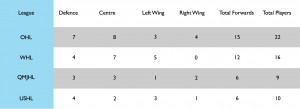If I told you the Québec Major Junior Hockey League (QMJHL) produced the least amount of draft eligible players that improved over the 2015-16 season, would you believe me? Furthermore, would you believe me if I said the QMJHL was home to the top development teams in the entire Canadian Hockey League (CHL)? Even though this league isn’t producing the most top talent, it is producing the most improved top talent.
Maybe you don’t believe me, but perhaps you’ll believe the NHL Central Scouting bureau and their ranking system.
The NHL Central Scouting Services (CSS) measures how well a player will translate from amateur to pro through a standardized ranking system. They recently released their 2016 NHL Draft prospect final rankings and this data tell us a lot of new information about North American skaters and thus supplies NHL General Managers and draft eligible players new information about our nation’s top development teams.
For the purposes of this article, the term ‘improvement’ is used to describe a player who has moved up in CSS rankings from midterm to final term. For example, Wade Allison (RW) of the USHL’s Tri-City Storm improved the most out of ALL players ranked by CSS, moving up 130 spots from #192 at midterm, to #62 in the final term.
The Analysis:
After going through the 240 North American skaters ranked in the final term, it appears that the higher a player ranks, the less likely he is to make a significant improvement over time. Consequently, the lower a player ranks at midterm, the more likely he is to have a significant improvement over time. As players improve between midterm and final term, there’s more parity amongst them.
This means that players who ranked lower at midterm are more likely to improve at a greater rate than players who ranked highly at midterm. Therefore, if you look at the face value of players who “improved the most” since midterm, a facade is created for the teams they played for, as these teams appear to have better player development systems.
However, by drilling down through the data, we can find which teams truly have the better player development systems in the CHL and consequently, which teams lure great talent from outside sources.
Top Talent Comes from Top Development Teams
Which CHL teams produced the most amount of improved players?
The following table shows CHL and USHL players ranked by CSS and categorized by position, who improved (increased in rank) since midterm:

As you can see, the QMJHL produced the least amount of players who improved between the midterm and final rankings.
There are 25 CHL teams that produced at least one player who ranked #50 or higher in the final term rankings. Of these 25 teams, some of their players ranked lower than #50 improved, while some players that ranked higher than #50 did not. Only 19 teams had players ranked #50 or higher, as well as players that improved on their roster:
1. Moose Jaw (WHL)
#22 Brett Howden (C) moved up five spots since the midterm rankings.
#45 Noah Gregor (C) moved up 30 spots since the midterm rankings.
2. Kelowna (WHL)
#26 Lucas Johansen (D) moved up 12 spots since the midterm rankings.
#41 Dillon Dube (C) moved down six spots since the midterm rankings.
3. Victoriaville (QMJHL)
#28 Pascal Laberge (C) moved up three spots since the midterm rankings.
4. Shawinigan (QMJHL)
#38 Samuel Girard (D) moved up two spots since the midterm rankings.
5. Gatineau (QMJHL)
#29 Vitaly Abramov (RW) moved up 27 spots since the midterm rankings.
6. Chicoutimi (QMJHL)
#32 Frederic Allard (D) moved up four spots since the midterm rankings.
7. Cape Breton (QMJHL)
#1 Pierre-Luc Dubois (LW) moved up six spots since the midterm rankings.
8. Windsor (OHL)
#7 Logan Brown (C) moved up seven spots since the midterm rankings.
#8 Mikhail Sergachev (D) moved up two spots since the midterm rankings.
#19 Logan Stanley (D) moved up four spots since the midterm rankings.
9. Sault Marie (OHL)
#25 Boris Katchouk (LW) moved up seven spots since the midterm rankings.
#33 Jack Kopacka (LW) didn’t move up or down since the midterm rankings.
#37 Timothy Gettinger (LW) moved down 9 spots since the midterm rankings.
10. North Bay (OHL)
#39 Cam Dineen (D) moved up 78 spots since the midterm rankings.
11. Kitchener (OHL)
#42 Adam Mascherin (LW) moved up 15 spots since the midterm rankings.
Of these19 teams, 11 produced players who ranked #50 or higher AND improved since the midterm. Two (out of five) are WHL teams, five (out of five) are QMJHL teams and four (out of nine) are OHL teams. This tells us that even though the QMJHL produces the least amount of improved players ranked by CSS, they are by far the best at taking top players and making them even better.
The 2016 NHL Entry Draft
The 2016 NHL Entry Draft is quickly approaching and clearly, the QMJHL has an influential presence on the NHL Draft floor. It comes at no surprise that the #1 ranking player on Central Scouting’s list this year is Pierre-Luc Dubois of the Cape Breton Screaming Eagles.
Next year’s Entry Draft is set to take place in Chicago and the QMJHL’s top development teams have a number of 2017 draft eligible players to look at:
- Peyton Hoyt (Cape Breton)
- Maxine Comtois (Victoriaville)
- Guillaume Beck (Victoriaville)
- Antoine Morand (Acadie-Bathurst)
- Joël Teasdale (Blainville-Boisbriand)
- Antoine Crête-Belzile (Blainville-Boisbriand)
- Yan Aucoin (Baie-Comeau)
- Shawn Boudrias (Charlottetown)
- Jocktan Chainey (Shawinigan)
- Louis-Philip Côte (Rouyn-Noranda)
It's official! The #Blackhawks will host the 2017 @NHL Draft, a first for the franchise! pic.twitter.com/p1ZSUqN69H
— Chicago Blackhawks (@NHLBlackhawks) February 11, 2016